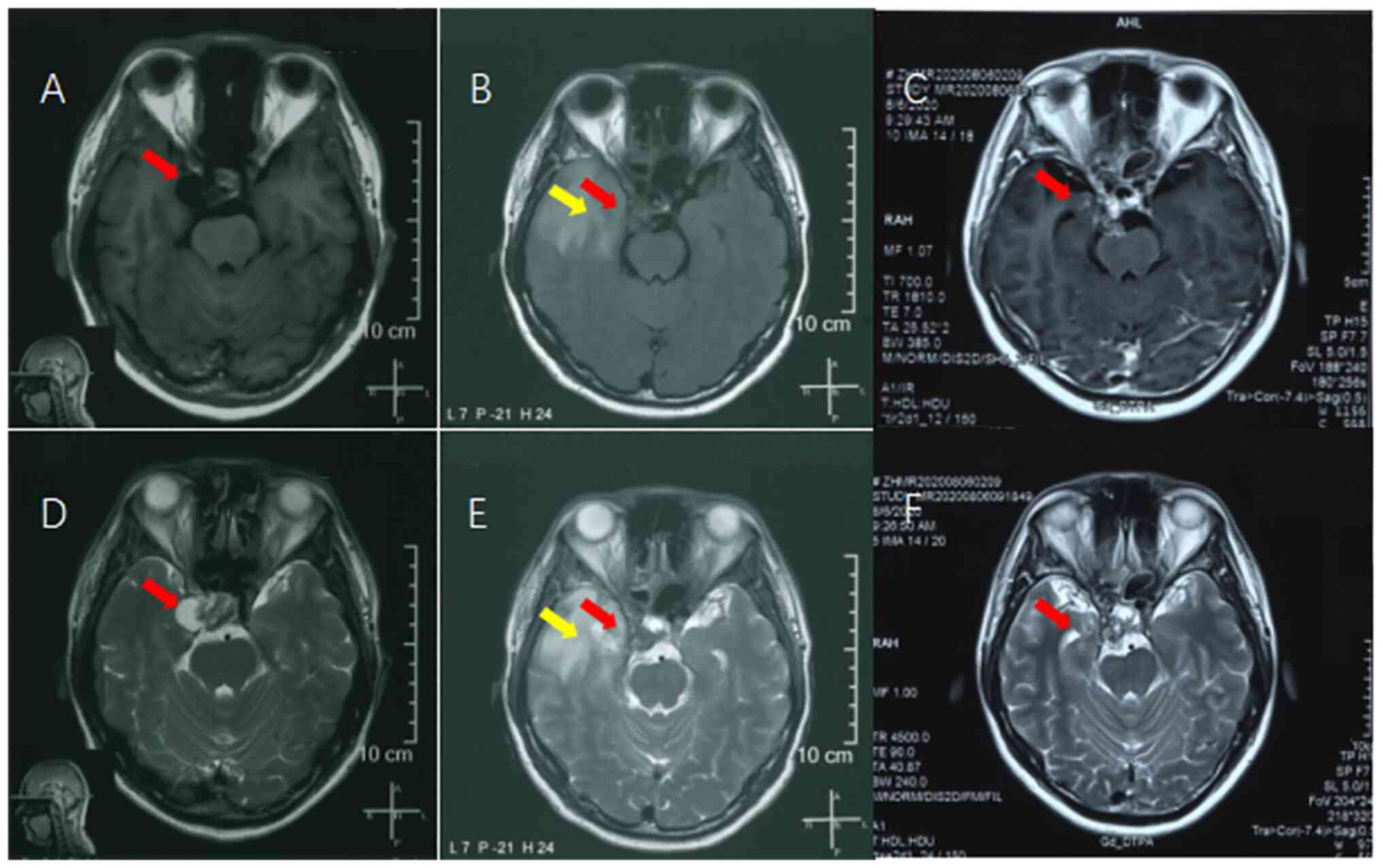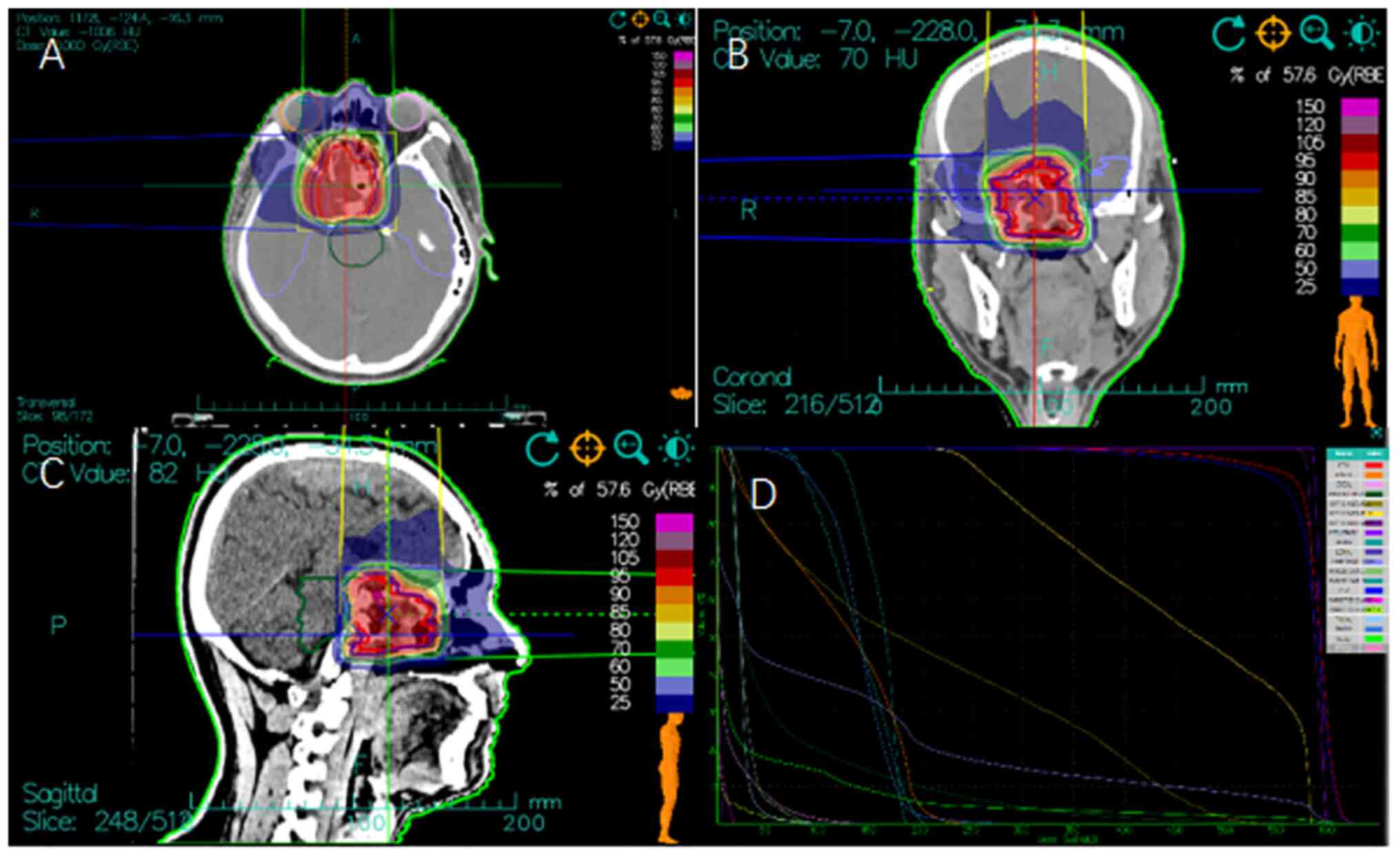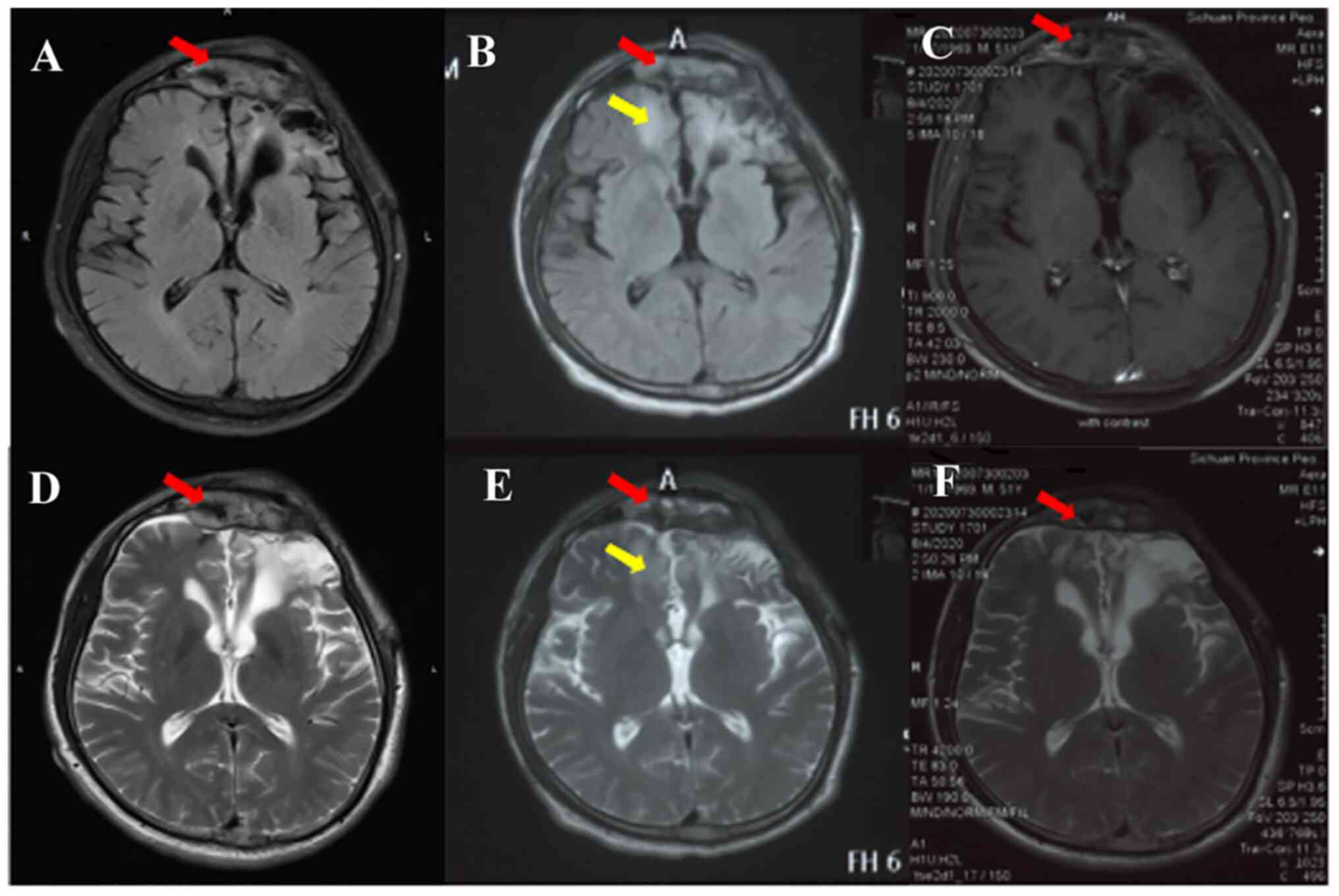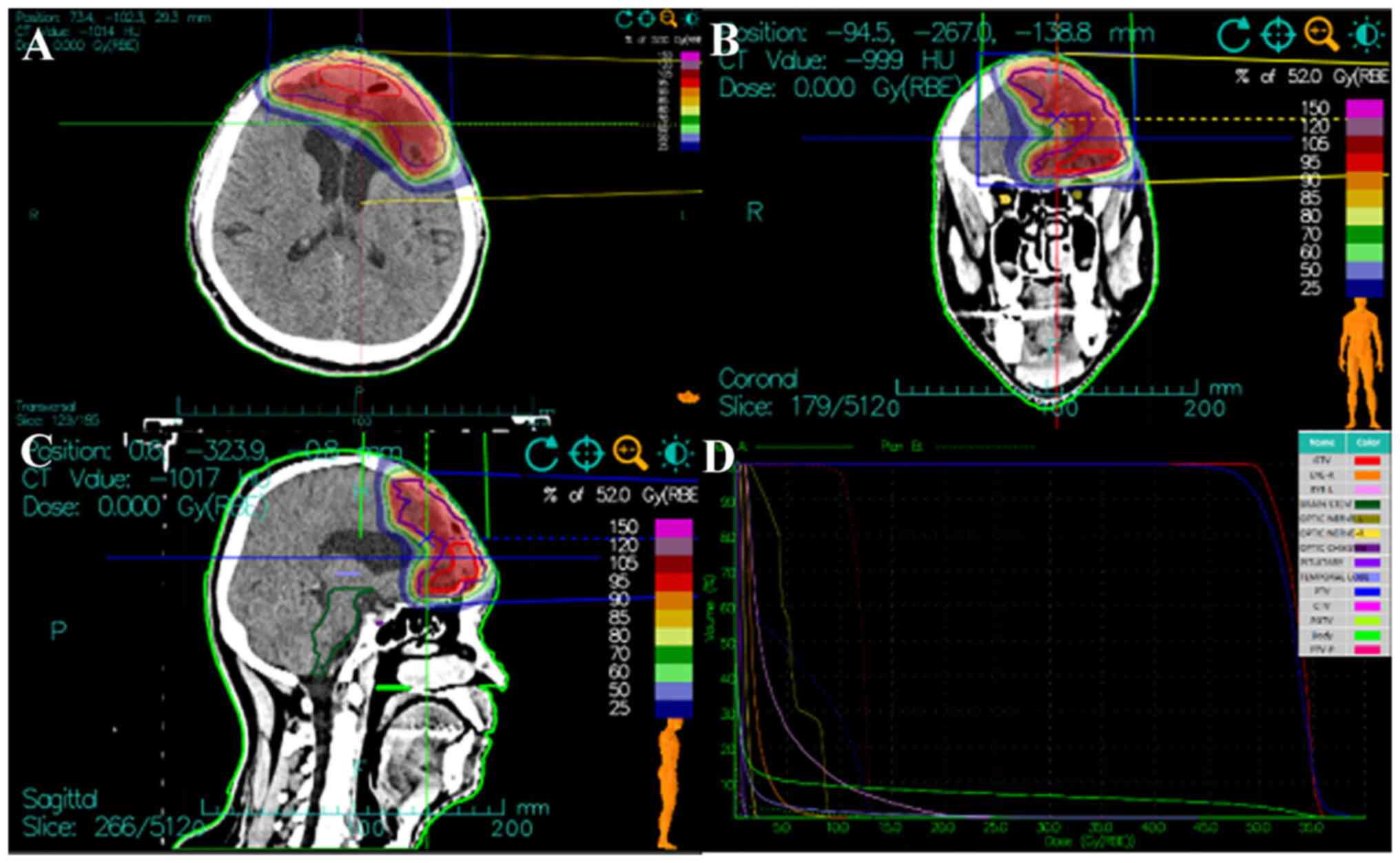|
1
|
Lapointe S, Perry A and Butowski NA:
Primary brain tumours in adults. Lancet. 392:432–446.
2018.PubMed/NCBI View Article : Google Scholar
|
|
2
|
Krauze AV, Peters C, Cheng J, Ning H,
Mackey M, Rowe L, Cooley-Zgela T, Smart DD and Camphausen K:
Re-irradiation for recurrent glioma- the NCI experience in tumor
control, OAR toxicity and proposal of a novel prognostic scoring
system. Radiat Oncol. 12(191)2017.PubMed/NCBI View Article : Google Scholar
|
|
3
|
Nieder C, Andratschke NH and Grosu AL:
Re-irradiation for recurrent primary brain tumors. Anticancer Res.
36:4985–4995. 2016.PubMed/NCBI View Article : Google Scholar
|
|
4
|
Kanai T, Endo M, Minohara S, Miyahara N,
Koyama-ito H, Tomura H, Matsufuji N, Futami Y, Fukumura A, Hiraoka
T, et al: Biophysical characteristics of HIMAC clinical irradiation
system for heavy-ion radiation therapy. Int J Radiat Oncol Biol
Phys. 44:201–210. 1999.PubMed/NCBI View Article : Google Scholar
|
|
5
|
Miyatake S, Nonoguchi N, Furuse M,
Yoritsune E, Miyata T, Kawabata S and Kuroiwa T: Pathophysiology,
diagnosis, and treatment of radiation necrosis in the brain. Neurol
Med Chir (Tokyo). 55:50–59. 2015.PubMed/NCBI
|
|
6
|
Soliman HM, ElBeheiry AA, Abdel-Kerim AA,
Farhoud AH and Reda MI: Recurrent brain tumor versus radiation
necrosis; can dynamic susceptibility contrast (DSC) perfusion
magnetic resonance imaging differentiate? Egyptian J Radiol Nuclear
Med. 49:719–726. 2018.
|
|
7
|
Delishaj D, Ursino S, Pasqualetti F,
Cristaudo A, Cosottini M, Fabrini MG and Paiar F: Bevacizumab for
the treatment of radiation-induced cerebral necrosis: A systematic
review of the literature. J Clin Med Res. 9:273–280.
2017.PubMed/NCBI View Article : Google Scholar
|
|
8
|
Amin MB, Edge SB, Greene FL, Byrd DR,
Brookland RK, Washington MK, Gershenwald JE, Compton CC, Hess KR,
Sullivan DC eds..et al: AJCC cancer staging manual. 8th ed.
NewYork: Springer; 2017.
|
|
9
|
Cox JD, Stetz J and Pajak TF: Toxicity
criteria of the radiation therapy oncology group (RTOG) and the
European organization for research and treatment of cancer (EORTC).
Int J Radiat Oncol Biol Phys. 31:1341–1346. 1995.PubMed/NCBI View Article : Google Scholar
|
|
10
|
Gritsch S, Batchelor TT and Gonzalez
Castro LN: Diagnostic, therapeutic, and prognostic implications of
the 2021 World Health Organization classification of tumors of the
central nervous system. Cancer. 128:47–58. 2022.PubMed/NCBI View Article : Google Scholar
|
|
11
|
Parvez K, Parvez A and Zadeh G: The
diagnosis and treatment of pseudoprogression, radiation necrosis
and brain tumor recurrence. Int J Mol Sci. 15:11832–11846.
2014.PubMed/NCBI View Article : Google Scholar
|
|
12
|
Rahmathulla G, Marko NF and Weil RJ:
Cerebral radiation necrosis: A review of the pathobiology,
diagnosis and management considerations. J Clin Neurosci.
20:485–502. 2013.PubMed/NCBI View Article : Google Scholar
|
|
13
|
Ali FS, Arevalo O, Zorofchian S, Patrizz
A, Riascos R, Tandon N, Blanco A, Ballester LY and Esquenazi Y:
Cerebral radiation necrosis: incidence, pathogenesis, diagnostic
challenges, and future opportunities. Curr Oncol Rep.
21(66)2019.PubMed/NCBI View Article : Google Scholar
|
|
14
|
Tessonnier T, Mairani A, Brons S, Haberer
T, Debus J and Parodi K: Experimental dosimetric comparison of
1H, 4He, 12C and 16O
scanned ion beams. Phys Med Biol. 62:3958–3982. 2017.PubMed/NCBI View Article : Google Scholar
|
|
15
|
Suit H, DeLaney T, Goldberg S, Paganetti
H, Clasie B, Gerweck L, Niemierko A, Hall E, Flanz J, Hallman J and
Trofimov A: Proton vs. carbon ion beams in the definitive radiation
treatment of cancer patients. Radiother Oncol. 95:3–22.
2010.PubMed/NCBI View Article : Google Scholar
|
|
16
|
Tinganelli W and Durante M: Carbon ion
radiobiology. Cancers (Basel). 12(3022)2020.PubMed/NCBI View Article : Google Scholar
|
|
17
|
Sakama M and Kanematsu N: An evaluation
method of clinical impact with setup, range, and radiosensitivity
uncertainties in fractionated carbon-ion therapy. Phys Med Biol.
63(135003)2018.PubMed/NCBI View Article : Google Scholar
|
|
18
|
Eley JG, Newhauser WD, Richter D,
Lüchtenborg R, Saito N and Bert C: Robustness of target dose
coverage to motion uncertainties for scanned carbon ion beam
tracking therapy of moving tumors. Phys Med Biol. 60:1717–1740.
2015.PubMed/NCBI View Article : Google Scholar
|
|
19
|
Kamp F, Brüningk S, Cabal G, Mairani A,
Parodi K and Wilkens JJ: Variance-based sensitivity analysis of
biological uncertainties in carbon ion therapy. Phys Med.
30:583–587. 2014.PubMed/NCBI View Article : Google Scholar
|
|
20
|
Meyer J, Bluett J, Amos R, Levy L, Choi S,
Nguyen QN, Zhu XR, Gillin M and Lee A: Spot scanning proton beam
therapy for prostate cancer: Treatment planning technique and
analysis of consequences of rotational and translational alignment
errors. Int J Radiat Oncol Biol Phys. 78:428–434. 2010.PubMed/NCBI View Article : Google Scholar
|
|
21
|
Lomax AJ: Intensity modulated proton
therapy and its sensitivity to treatment uncertainties 1: The
potential effects of calculational uncertainties. Phys Med Biol.
53:1027–1042. 2008.PubMed/NCBI View Article : Google Scholar
|
|
22
|
Malouff TD, Mahajan A, Krishnan S, Beltran
C, Seneviratne DS and Trifiletti DM: Carbon ion therapy: A modern
review of an emerging technology. Front Oncol.
10(82)2020.PubMed/NCBI View Article : Google Scholar
|
|
23
|
Kondo N, Sakurai Y, Takata T, Takai N,
Nakagawa Y, Tanaka H, Watanabe T, Kume K, Toho T, Miyatake S, et
al: Localized radiation necrosis model in mouse brain using proton
ion beams. Appl Radiat Isot. 106:242–246. 2015.PubMed/NCBI View Article : Google Scholar
|
|
24
|
Sun XZ, Takahashi S, Kubota Y, Zhang R,
Cui C, Nojima K and Fukui Y: Experimental model for irradiating a
restricted region of the rat brain using heavy-ion beams. J Med
Invest. 51:103–107. 2004.PubMed/NCBI View Article : Google Scholar
|
|
25
|
Takahashi S, Sun XZ, Kubota Y, Takai N and
Nojima K: Histological and elemental changes in the rat brain after
local irradiation with carbon ion beams. J Radiat Res. 43:143–152.
2002.PubMed/NCBI View Article : Google Scholar
|
|
26
|
Grosshans DR, Duman JG, Gaber MW and
Sawakuchi G: Particle radiation induced neurotoxicity in the
central nervous system. Int J Part Ther. 5:74–83. 2018.PubMed/NCBI View Article : Google Scholar
|
|
27
|
Mayer R and Sminia P: Reirradiation
tolerance of the human brain. Int J Radiat Oncol Biol Phys.
70:1350–1360. 2008.PubMed/NCBI View Article : Google Scholar
|
|
28
|
Nonoguchi N, Miyatake S, Fukumoto M,
Furuse M, Hiramatsu R, Kawabata S, Kuroiwa T, Tsuji M, Fukumoto M
and Ono K: The distribution of vascular endothelial growth
factor-producing cells in clinical radiation necrosis of the brain:
Pathological consideration of their potential roles. J Neurooncol.
105:423–431. 2011.PubMed/NCBI View Article : Google Scholar
|
|
29
|
Zhuang H, Shi S, Yuan Z and Chang JY:
Bevacizumab treatment for radiation brain necrosis: Mechanism,
efficacy and issues. Mol Cancer. 18(21)2019.PubMed/NCBI View Article : Google Scholar
|
|
30
|
Shaw EG and Robbins ME: The management of
radiation-induced brain injury. Cancer Treat Res. 128:7–22.
2006.PubMed/NCBI View Article : Google Scholar
|
|
31
|
Lam TC, Wong FC, Leung TW, Ng SH and Tung
SY: Clinical outcomes of 174 nasopharyngeal carcinoma patients with
radiation-induced temporal lobe necrosis. Int J Radiat Oncol Biol
Phys. 82:e57–e65. 2012.PubMed/NCBI View Article : Google Scholar
|
|
32
|
Zhuo X, Huang X, Yan M, Li H, Li Y, Rong
X, Lin J, Cai J, Xie F, Xu Y, et al: Comparison between high-dose
and low-dose intravenous methylprednisolone therapy in patients
with brain necrosis after radiotherapy for nasopharyngeal
carcinoma. Radiother Oncol. 137:16–23. 2019.PubMed/NCBI View Article : Google Scholar
|
|
33
|
Khan M, Zhao Z, Arooj S and Liao G:
Bevacizumab for radiation necrosis following radiotherapy of brain
metastatic disease: A systematic review & meta-analysis. BMC
Cancer. 21(167)2021.PubMed/NCBI View Article : Google Scholar
|
|
34
|
Levin VA, Bidaut L, Hou P, Kumar AJ, Wefel
JS, Bekele BN, Grewal J, Prabhu S, Loghin M, Gilbert MR and Jackson
EF: Randomized double-blind placebo-controlled trial of bevacizumab
therapy for radiation necrosis of the central nervous system. Int J
Radiat Oncol Biol Phys. 79:1487–1495. 2011.PubMed/NCBI View Article : Google Scholar
|
|
35
|
Lubelski D, Abdullah KG, Weil RJ and Marko
NF: Bevacizumab for radiation necrosis following treatment of high
grade glioma: A systematic review of the literature. J Neurooncol.
115:317–322. 2013.PubMed/NCBI View Article : Google Scholar
|
|
36
|
Tye K, Engelhard HH, Slavin KV, Nicholas
MK, Chmura SJ, Kwok Y, Ho DS, Weichselbaum RR and Koshy M: An
analysis of radiation necrosis of the central nervous system
treated with bevacizumab. J Neurooncol. 117:321–327.
2014.PubMed/NCBI View Article : Google Scholar
|
|
37
|
Bodensohn R, Hadi I, Fleischmann DF,
Corradini S, Thon N, Rauch J, Belka C and Niyazi M: Bevacizumab as
a treatment option for radiation necrosis after cranial radiation
therapy: A retrospective monocentric analysis. Strahlenther Onkol.
196:70–76. 2020.PubMed/NCBI View Article : Google Scholar
|
|
38
|
Wang Y, Pan L, Sheng X, Mao Y, Yao Y, Wang
E, Zhang N and Dai J: Reversal of cerebral radiation necrosis with
bevacizumab treatment in 17 Chinese patients. Eur J Med Res.
17(25)2012.PubMed/NCBI View Article : Google Scholar
|
|
39
|
Gonzalez J, Kumar AJ, Conrad CA and Levin
VA: Effect of bevacizumab on radiation necrosis of the brain. Int J
Radiat Oncol Biol Phys. 67:323–326. 2007.PubMed/NCBI View Article : Google Scholar
|
|
40
|
Furuse M, Nonoguchi N, Kawabata S,
Yoritsune E, Takahashi M, Inomata T, Kuroiwa T and Miyatake S:
Bevacizumab treatment for symptomatic radiation necrosis diagnosed
by amino acid PET. Jpn J Clin Oncol. 43:337–341. 2013.PubMed/NCBI View Article : Google Scholar
|
|
41
|
Tejpar S, Prenen H and Mazzone M:
Overcoming resistance to antiangiogenic therapies. Oncologist.
17:1039–1050. 2012.PubMed/NCBI View Article : Google Scholar
|
|
42
|
Vasudev NS and Reynolds AR:
Anti-angiogenic therapy for cancer: Current progress, unresolved
questions and future directions. Angiogenesis. 17:471–494.
2014.PubMed/NCBI View Article : Google Scholar
|
|
43
|
Jeyaretna DS, Curry WT Jr, Batchelor TT,
Stemmer-Rachamimov A and Plotkin SR: Exacerbation of cerebral
radiation necrosis by bevacizumab. J Clin Oncol. 29:e159–e162.
2011.PubMed/NCBI View Article : Google Scholar
|


















